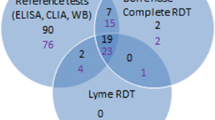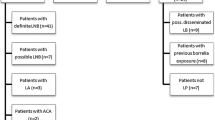Abstract
An enzyme immunoassay (EIA) developed for the diagnosis of Lyme borreliosis was tested for its specificity and sensitivity in detecting IgG antibodies in patients at various stages of the disease. The EIA is based on a detergent extract ofBorrelia burgdorferi which contains 12 proteins of defined molecular weights fromBorrelia burgdorferi. The assay showed a specificity of 100 % in control sera from 64 healthy individuals, using a cut-off optical density value of 0.13 (\(\bar x \pm 3SD\)). The sensitivity was 100 % using sera from 22 Swedish patients with late stage Lyme borreliosis and 43 % using sera from 30 patients with the initial stage of the disease. The reactivity of the sera against whole cell preparations, the outer surface proteins OspA and OspB, and the flagella ofBorrelia burgdorferi was also tested and compared with the EIA. No cross-reactivity with treponemal antigens was observed when using the EIA.
Similar content being viewed by others
References
Burgdorfer W, Barbour AG, Hayes SF, Benach JL, Grunwaldt E, Davis, JP: Lyme disease — a tick borne spirochetosis? Science 1983, 216: 1317–1319.
Steere AC, Grodzicki RL, Kornblatt AN, Craft JE, Barbour AG, Burgdorfer W, Schmid GP, Johnson E, Malawista SE: The spirochetal etiology of Lyme disease. New England Journal of Medicine 1983, 308: 733–740.
Johnson RC, Schmid GP, Hyde FW, Steigerwalt AG, Brenner DJ:Borrelia burgdorferi sp. nov. Etiologic agent of Lyme disease. International Journal of Systematic Bacteriology 1984, 4: 496–497.
Steere AC, Bartenhagen NH, Craft JE, Hutchinson GJ, Newman JH, Rahn DW, Sigal LH, Spieler PN, Stenn KS, Malawista SE: The early clinical manifestations of Lyme disease. Annals of Internal Medicine 1983, 99: 76–82.
Åsbrink E, Hovmark A: Successful cultivation of spirochetes from skin lesions of patients with erythema chronicum migrans Afzelius and acrodermatitis chronica atrophicans. Acta Pathologica, Microbiologica et Immunologica Scandinavica (B) 1985, 93: 161–163.
Stiernstedt G, Granström M, Hederstedt B, Sköldenberg B: Diagnosis of spirochetal meningitis by enzyme-linked immunosorbent assay and indirect immunosorbent assay in serum and cerebrospinal fluid. Journal of Clinical Microbiology 1985, 21: 819–825.
Craft JE, Grodzicki RL, Steere AC: Antibody response in Lyme disease: evaluation of diagnostic tests. Journal of Infectious Diseases 1984, 149: 789–795.
Russell H, Sampson JS, Schmid GP, Wilkinson HW, Plikaytis B: Enzyme-linked immunosorbent assay and indirect immunofluorescens assay for Lyme disease. Journal of Infectious Diseases 1984, 149: 465–470.
Magnarelli LA, Meegan JM, Anderson JF, Chappell WA: Comparison of an indirect fluorescent-antibody test with an enzyme-linked immunosorbent assay for serological studies of Lyme disease. Journal of Clinical Microbiology 1984, 20: 181–184.
Shresta M, Grodzicki RL, Steere AC: Diagnosing early Lyme disease. American Journal of Medicine 1985, 78: 235–240.
Magnarelli LA, Anderson JF: Early detection and persistence of antibodies toBorrelia burgdorferi in persons with Lyme disease. Zentralblatt für Bakteriologie, Mikrobiologie und Hygiene (A) 1986, 263: 392–400.
Magnarelli LA, Anderson JF, Johnson RC: Cross-reactivity in serologic tests for Lyme disease and other spirochetal infections. Journal of Infectious Diseases 1987, 156: 183–188.
Grodzicki RL, Steere AC: Comparison of immunoblotting and indirect enzyme-linked immunosorbent assay using different antigen preparations for diagnosing early Lyme disease. Journal of Infectious Diseases 1988, 157: 790–797.
Coleman JL, Benach JL: Isolation of antigenic components from the Lyme disease spirochete: their role in early diagnosis. Journal of Infectious Diseases 1987, 155: 756–765.
Hansen K, Hindersson P, Pedersen NS: Measurements of antibodies toBorrelia burgdorferi flagellum improves serodiagnosis in Lyme disease. Journal of Clinical Microbiology 1988, 26: 338–346.
Hansen K, Åsbrink E: Serodiagnosis of erythema migrans and acrodermatitis chronica atrophicans by theBorrelia burgdorferi flagellum enzyme-linked immunosorbent assay. Journal of Clinical Microbiology 1989, 27: 545–551.
Waaler E: On the occurrence of a factor in human serum activating the specific agglutination of sheep blood corpuscles. Acta Pathologica et Microbiologica 1940, 17: 172–177.
Burnham TK, Bank PW: Antinuclear antibodies. I. Pattern of nuclear immunofluorescens. Journal of Investigative Dermatology 1974, 62: 526–534.
Wassermann A, Neisser A, Bruch C: Eine serodiagnostische Reaktion bei Syphilis. Deutsche Medizinische Wochenschrift 1906, 32: 745–746.
Åsbrink E, Hovmark A, Hederstedt B: The spirochetal etiology of acrodermatitis chronicum atrophicans Herxheimer. Acta Dermatologica et Venereologica 1984, 64: 506–512.
Barbour AG: Isolation and cultivation of Lyme disease spirochete. Yale Journal of Biological Medicine 1984, 57: 521–525.
Magnarelli LA, Anderson JF, Barbour AG: Enzymelinked immunosorbent assays for Lyme disease: reactivity of subunits ofBorrelia burgdorferi. Journal of Infectious Diseases 1989, 159: 43–49.
Barbour AG, Heiland RA, Howe TR: Heterogeneity of major proteins in Lyme disease borreliae: a molecular analysis of North American and European isolates. Journal of Infectious Diseases 1985, 152: 478–484.
Barbour AG: Immunochemical analysis of Lyme disease spirochetes. Yale Journal of Biological Medicine 1984, 57: 581–586.
Barbour AG, Hayes SF, Heiland RA, Schrumpf ME, Tessier SL: ABorrelia specific monoclonal antibody binds to a flagellar epitope. Infection and Immunity 1986, 52: 549–554.
Wilske B, Preac-Mursic V, Schierz G, von Busch K: Immunochemical and immunological analysis of EuropeanBorrelia burgdorferi strains. Zentralblatt für Bakteriologie, Mikrobiologie und Hygiene (A) 1986, 263: 92–102.
Author information
Authors and Affiliations
Rights and permissions
About this article
Cite this article
Bergström, S., Sjöstedt, A., Dotevall, L. et al. Diagnosis of Lyme borreliosis by an enzyme immunoassay detecting immunoglobulin G reactive to purifiedBorrelia burgdorferi cell components. Eur. J. Clin. Microbiol. Infect. Dis. 10, 422–427 (1991). https://doi.org/10.1007/BF01968022
Issue Date:
DOI: https://doi.org/10.1007/BF01968022




